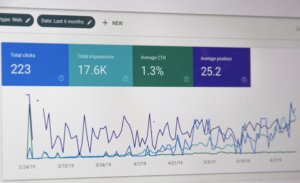SEO for Higher Education Institutions: Invest Now Or Pay Later
September 7th, 2023 by
Key Insights:
- Institutions need to maintain a well-optimized online presence to ensure they connect with students effectively.
- Even though SEO is foundational for digital marketing, 51% of universities lack a well-defined SEO plan, representing a significant missed opportunity for increased visibility and engagement.
- SEO can’t be sidelined or delayed, especially with the increasing number of educational programs and the stagnant or declining pool of potential students.
- Online platforms, boot camps, and micro-credential programs challenge the traditional models of education. As these alternative educational models gain traction, traditional institutions must leverage SEO to differentiate themselves and maintain their competitive edge.
In a world where undergraduate college enrollment is on a 10-year decline, according to Brookings, higher education deans and marketing managers are searching for ways to get their programs in front of prospective students.
Yet, they often overlook SEO (search engine optimization). It’s one of the basics of digital marketing — and digital marketing and institutional leaders know this!
According to the Search Influence and UPCEA Higher Ed Research Study, digital marketing and institutional leaders see SEO as foundational but admit their PCO units lack an SEO strategy.
In the same study, we found that 51% of universities don’t have an established SEO plan.
This is a massive missed opportunity.
But not to worry!
SEO has been here waiting — knowing that you’d soon realize what you always needed was right in front of you the whole time.
Still, SEO won’t wait forever.
To take advantage of SEO, you need to invest in it now — rather than later. In this blog post, I’ll share why.

The Importance of SEO for Higher Education
In our digital world, a well-optimized website is no longer a luxury; it’s a necessity.
As UPCEA Chief Research Officer Jim Fong said in our Spring 2023 webinar, “SEO is not something institutions can kick the can down the road on. It’s going to become increasingly important, especially as the number of programs increases and the number of potential students stays the same or even decreases.”
SEO for higher education can impact your enrollment in a multitude of ways, including:
- First touchpoint: Many students first encounter institutions via online search, making visibility crucial for first impressions.
- Positive digital footprint: A well-optimized educational website offers more than visibility — it establishes trust and credibility.
- Building credibility: High search rankings not only boost visibility but also enhance institutional reputation in the eyes of prospects.
- Actionable insights: SEO analytics reveal what potential students seek, allowing institutions to fine-tune their offerings.
- Engaging prospects: Beyond visibility, an SEO-driven content strategy can guide students through their decision-making process.
- Adapting to change: With the dynamic nature of SEO, institutions can stay relevant in shifting search landscapes.
Why You Need to Invest in Higher Education SEO Now
As the UPCEA and Search Influence Research Study asserted, “A poor foundation for an SEO strategy creates cracks in the larger infrastructure of your website. And just like the potholes in an old city make the roads challenging to navigate, when SEO doesn’t receive the attention it deserves, websites become difficult to navigate and can slip through the cracks — overlooked by search engines and prospects.”
The growing competition in higher education
“As the choices for potential students grow, the challenge for educational institutions to differentiate themselves intensifies.”
In the past decade, the higher education landscape has witnessed a radical shift. Traditional brick-and-mortar institutions now share the educational stage with many other online platforms. From Coursera to Udemy and edX, the options for acquiring knowledge have become vast, decentralized, and more accessible.
These alternative education models offer specialized training and often come with the backing or endorsement of industry giants, making them immensely appealing to students searching for immediate value and application.
As the choices for potential students grow, the challenge for educational institutions to differentiate themselves intensifies.
One major trend increasing this competition is the growth of online classes and degrees. Previously, an institution’s reputation might have been enough to draw in students from local or even international areas. Today, the boundaries have blurred.
Additionally, the rise of college and university “boot camps,” certification programs, and micro-credentials have reshaped the way we think about education.
These flexible programs that teach work-ready skills at a lower price have students thinking:
“Why commit to a four-year degree when a six-month boot camp promises practical skills and potential job placements?”
This education evolution has left higher ed institutions searching for new ways to remain in contention.
SEO can help you cut through the competition.
SEO helps universities reach their target audience in a crowded market, whether it’s for popular courses or specialized subjects. Having a strong online presence and using SEO helps universities gain credibility and meet the changing search habits of younger generations.
The changing landscape: no longer a growth market
“Yet, amidst this backdrop of challenges lies untapped potential. A significant demographic of 40.4 million people have college experience but no degree, as highlighted by the NSC Research Center. This segment represents a ripe opportunity for institutions.”
Higher education has had difficulties in the last ten years, no longer growing as quickly as before. Key among these challenges is the decline in enrollment.
According to Brookings, from 2010 to 2021, undergraduate enrollment in the U.S. decreased by 2.6 million students, with the most significant drops observed between fall 2019 and 2021.
Brookings attributes this decline to a mix of factors. The burgeoning student loan debt, especially prevalent in the U.S., planted seeds of doubt in the minds of many about the return on investment for a college degree.
When combined with the soaring tuition costs in numerous regions, it’s not hard to see why potential students might be deterred from higher education or pivot to more affordable alternatives.
Furthermore, the rapid pace of technological advancements challenges the relevance of specific degree programs, with potential students questioning the longevity of what they’re learning.
Yet, amidst this backdrop of challenges lies untapped potential. A significant demographic of 40.4 million people have some college experience but no degree, as highlighted by the NSC Research Center. This segment represents a ripe opportunity for institutions.
With the right SEO strategies, universities can specifically target this group, offering them tailored programs and opportunities to complete their education.
Understanding and Catering to the Modern Student
“From researching courses and reading reviews to watching virtual campus tours and even enrolling, these tasks are increasingly being done on the go. Recognizing this, it’s paramount for universities to offer a robust mobile experience. It’s not just about aesthetics; it’s about efficiency.”
The face of the modern student has transformed.
A steady decline in the traditional 18-22-year-old demographic enrolling in universities is proven.
However, when one door closes, another one opens. Universities have an opportunity in the growing demographic of adult learners — specifically those with some credit but no degree. These learners seek innovative, stackable online programs catering to their unique needs and life situations.
Beyond this, the modern student desires holistic experiences encompassing practical knowledge, hands-on experiences, and a tangible path leading to employment.
This calls for a departure from the traditional way universities craft their programs. Modern students want an educational model that respects their time and commitments, allowing them to juggle work, family, and studies. This is where online courses or hybrid models come into play, offering them the flexibility they seek.
Properly harnessed SEO tools offer insights into the digital behavior of these students.
What courses do they search for?
What kind of educational content engages them?
Understanding these patterns and trends enables institutions to fine-tune their offerings and higher education marketing strategies to resonate more effectively with their target audience.
Parallel to this is the shift to mobile. The modern student’s relationship with mobile devices is not just about staying connected — it’s about consumption and convenience.
From researching courses and reading reviews to watching virtual campus tours and even enrolling, these tasks are increasingly being done on the go. Recognizing this, it’s paramount for universities to offer a robust mobile experience. It’s not just about aesthetics; it’s about efficiency.
Maximizing Exposure with Search Engine Optimization
In the digital era, institutions must recognize the power of SEO to amplify their visibility among potential students. Institutions can ascend in search engine rankings by skillfully blending keywords, ensuring excellent content, and optimizing site structure. This not only boosts online presence but also fortifies credibility in the eyes of prospective students.
Universities can employ several SEO tactics and tools to achieve this heightened exposure:
- Keyword research: Utilizing platforms like Google Keyword Planner or SEMrush allows institutions to discern the terms that resonate most with potential students, ensuring that their content speaks directly to these queries.
- On-page SEO: This encompasses the meticulous optimization of individual web pages. It means refining content to be supremely relevant and ensuring meta tags, URLs, and images meet the gold standard.
- Link building: Curating authentic, top-tier backlinks to an institution’s website can significantly boost SEO standings.
- Analytic tools: Solutions such as Google Analytics offer valuable windows into visitor interactions, spotlighting potential areas of enhancement.
Engaging Potential Students: More Than Just Visibility
“SEO seamlessly links sudent’s ambitions and curiosities with educational institutions’ diverse offerings and promises”
While it’s easy to perceive SEO merely as a tool for visibility, its potential is far more encompassing.
Beyond driving an institution to the top of search results, SEO plays a critical role in aligning with and appealing to the genuine interests of potential students.
Effective SEO delves deeper than the superficial metrics of rankings and algorithmic nuances.
At its heart, SEO is attuned to the pulse of user intent. When institutions fine-tune their content based on SEO insights, they aren’t just adhering to search engine protocols. They’re reshaping their narratives and offerings to resonate with what potential students are earnestly seeking.
SEO seamlessly links students’ ambitions and curiosities with educational institutions’ diverse offerings and promises.
Learn More About SEO for Educational Institutions With Search Influence
The competition for prospective students is fierce in higher education — waiting is not an option. Every moment an institution delays leveraging the power of SEO, they potentially lose out on a student, a connection, or an opportunity to make an impact.
Investing in SEO sooner rather than later isn’t just a proactive step — it’s a strategic necessity. Early adoption ensures a competitive edge, allowing institutions to engage and resonate with potential students in real time.
Ready to rank higher on SERPs and increase your university’s organic traffic?
Still not sure whether you should do your SEO in-house or outsource it? Take Search Influence’s In-House vs. Outsourcing SEO Quiz to get quick, custom recommendations today.
Our higher education digital marketing agency has been helping universities nationwide for years.
Including helping our longtime partner, Tulane SoPA, increase their organic traffic by 90%.
Download our research study we conducted with UPCEA to learn more about our work in SEO for higher education.
Image Sources:





